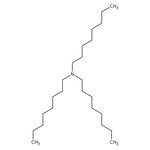Search Thermo Fisher Scientific
Tri-n-octilamina, 95 %, Thermo Scientific Chemicals



Tri-n-octilamina, 95 %, Thermo Scientific Chemicals
Identificadores químicos
Especificaciones
Descripción
This Thermo Scientific Chemicals brand product was originally part of the Alfa Aesar product portfolio. Some documentation and label information may refer to the legacy brand. The original Alfa Aesar product / item code or SKU reference has not changed as a part of the brand transition to Thermo Scientific Chemicals.
La Tri-n-octilamina se utiliza como un agente de extracción para ácidos orgánicos como el ácido tricloroacético, el ácido succínico, el ácido acético y los metales preciosos. También se utiliza como disolvente y como intermediario en la fabricación de productos farmacéuticos. Además, se emplea en la preparación de compuestos cuaternarios de amonio, productos agroquímicos, surfactantes, aditivos lubricantes, inhibidores de corrosión, aceleradores de vulcanización y colorantes.
Solubilidad
Miscible con cloroformo. No miscible con agua.
Notas
Sensible al aire. Incompatible con agentes oxidantes fuertes, dióxido de carbono, ácidos, cloruros de ácidos y anhídridos de ácidos.
Figuras
Documentos y descargas
Certificados
Preguntas frecuentes
Citas y referencias
Seguridad y manipulación
Classification of the substance or mixture
CLP classification - Regulation(EC) No 1272/2008
Label Elements
Signal Word
Danger
Hazard Statements
H315 - Causes skin irritation
H319 - Causes serious eye irritation
H360 - May damage fertility or the unborn child
H372 - Causes damage to organs through prolonged or repeated exposure
H410 - Very toxic to aquatic life with long lasting effects
Precautionary Statements
P280 - Wear protective gloves/protective clothing/eye protection/face protection
P302 + P352 - IF ON SKIN: Wash with plenty of soap and water
P305 + P351 + P338 - IF IN EYES: Rinse cautiously with water for several minutes. Remove contact lenses, if present and easy to do. Continue rinsing
P308 + P313 - IF exposed or concerned: Get medical advice/attention
P332 + P313 - If skin irritation occurs: Get medical advice/attention
Additional EU labelling
Restricted to professional users